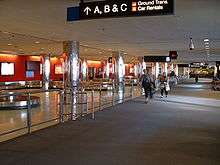Baggage reclaim
- This article is about the airport location. For the song by Miranda Lambert, see "Baggage Claim". For the 2013 film, see Baggage Claim (film).

In airport terminals, a baggage reclaim area is an area where arriving passengers claim checked-in baggage after disembarking from an airline flight.[1] The alternative term baggage claim is used at airports in the USA.[1]
A typical baggage claim area contains baggage carousels or conveyor systems that deliver checked baggage to the passenger. The baggage claim area generally contains the airline's customer service counter for claiming oversized baggage or to report missing baggage.
Some airports required that passengers display their baggage check receipt so that it can be positively matched against the bag they are trying to remove from baggage claim. This serves two purposes: first it reduces baggage theft, and secondly it helps to prevent passengers from accidentally leaving the airport with another passenger's bag that bears resemblance to their own.
For international arrivals, the baggage reclaim area is a restricted area, after immigration control and before clearing customs, so that all baggage can be inspected by customs agents,[2] but the passenger does not have to handle heavy baggage while moving through the passport booth. In the United States and Canada, and also in some airports in Asia, all arriving international passengers' baggage is claimed here and can be re-surrendered to the airline for connecting flights on the other side of customs (for connection from international to domestic flights in most countries, all passengers must claim their baggage). In most other countries passengers transferring to an onward flight do not need to collect their bags unless their airline does not offer to check their bags to their final destination. This is required in American and some Canadian airports because international terminals are not enclosed (the only exit being through customs) and often serve domestic flights. The same rule applies in the case of airports that have U.S. border preclearance facilities. This means that passengers continuing onto the U.S. from other cities must retrieve their checked baggage first, then re-check them after clearing U.S. Customs.
Depending on the airport, the domestic baggage reclaim area may be located next to or shared with the international reclaim area, or sometimes located in the public part of the airport alongside car rental desks and airport exits, and only passengers at their final destination claim their bags here. In most large airports in the United States and in some small ones as well, the domestic baggage reclaim is located on a different floor than the ticket counter, usually lower.
Efficiency of baggage claim units
The efficiency of baggage reclaim units can be measured in a number of ways including the amount of time a unit is in use for a given flight or the amount of baggage a unit can hold.[3] A number of factors can independently affect the efficiency of a particular unit:[3]
- Aircraft seating capacity
- Proportion of passengers with checked luggage
- Proportion of passengers who are terminating at a given destination
- Average number of luggage pieces per passenger
- Average traveling party size
- Average number of people at baggage reclaim
- Average rate at which luggage are unloaded from the flight (this also depends on the physical properties of checked luggage)

See also
References
- 1 2 Edwards, Brian (2005). The modern airport terminal: new approaches to airport architecture (2nd ed.). New York: Taylor & Francis. p. 116. ISBN 0-415-24812-4.
- ↑ Michael James Cassidy; Joseph D. Navarrete (2009). Airport passenger-related processing rates guidebook. Transportation Research Board. p. 11. ISBN 0-309-11805-0.
- 1 2 Landrum & Brown (2010). Airport Passenger Terminal Planning and Design: Spreadsheet models and user's guide. Transportation Research Board. pp. 53–54. ISBN 0-309-11816-6.